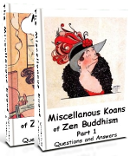History of Buddha - Facts and Fiction
Zen Riddle #23-piss :
Does a dog in heaven piss in front of a Buddha shrine?
Here's the answer....(Show/Hide)
Want more riddles? Choose one!
#16-bridge #17-curves #20-rice mumonkan
The history of Buddha is the legend of Siddharta Gotama, a 6th century BC Indian farmer, who first became a wandering ascetic, later a Buddha who's teachings were finally accepted by Chinese taoists.
He was an ethnic Shakya, most probably born 563 BC in north-east Indian close to the Himalayas.
At the age of 29 he left home for a spiritual life and perhaps from 528 BC onwards he was seen as an enlightened sage, a Buddha. He taught for 40 years and died perhaps in 483 BC.
About 20 years after the Buddha's death ethnic Shakyas were not known any more.
These meagre biographical details of a brief history of Buddhism are uncertain. Each national branch of Buddhism has its own version of it. Some experts in ancient Indian history even doubt whether a real person called "Buddha" ever existed.
North-east India during the Time of Buddha
An ascetic like Siddharta Gotama (Shakyamuni) fits quite well into the cultural and political situation in North-east India during seventh century BCE to fifth century CE.

The Buddha's Tender Teaching of a Rich Monk
But suddenly small cities developed and farmer communities became kingdoms.
Trade and agricultural production intensified and an era of social change began. New religious movements like Jainism and Buddhism challenged the traditional, Brahmin dominated culture and the trade of ancient India.
Ascetic beggars, some were seen as sages (muni) preached non-violence (ahimsa) and social equality. They opposed the religious sacrifice of cows by Brahmins to validate their teachings.
Most of these teachers developed new concepts of karma, soul, life and death. Some of these groups were only short-lived others lasted for centuries.
 The Lost Sutra of Buddhas' Life
The Lost Sutra of Buddhas' Life
The Shakya Siddharta Gotama muni
Siddharta Gotama, the sage (muni) from the Himalayas, may have been one of these new preachers.
But the traditional history of Buddha is derived from a bunch of inconsistent legends about his life and his teachings.
The earliest were (most probably) made up about hundred years after his death and later continuously extended with miraculous details.
But historical facts are less important for Buddhists, then the true teaching, the "dhamma". Just one example.
In a conversation the Indo-Greek king Milinda Menander (middle of second century B.C.) challenged the Buddhist monk Nagasena.
How Nagasena could vouch for the historical existence of the Buddha, the king asked, if he himself nor or of his immediate predecessors couldn't claim to have seen the Buddha personally.
Nagasena replied: The true historical Buddha can be perceived through the dhamma-body.
The dhamma is the Buddha, Nagasena said.
The Indian Buddha Legend
The birth of Siddharta Gotama is surrounded by fairy tales.
He was born, it was said, with a golden face. Immediately after being born he started walking and preaching his core message:
All the world is already enlightened!
His parents didn't want Siddharta to become a sage as they were foretold and shielded him from the world.
But Siddharta discovered the suffering of people and decided to become a holy man, a traditional ascetic.
But first he married and fathered a child. Only at the age of 29 years he left home to full-fill his mission.
Together with some friends he went into extreme ascetic practices. Gotama did his exercises always a bit harder.
After six years of torturing himself Siddharta was exhausted and nearly dead.
Spiritually he hadn't achieved anything.
In this desperation Siddharta remembered some easy meditation techniques he had used as a boy.
He decide to give up the ascetic life except the meditation practice.He only needed some month for mastering meditation: after a night of meditation he silently saw the morning star.
This was his first Buddhist enlightenment and he said again: All the world is already already enlightened.
The story of Buddha's shortcut to enlightenment without ascetic practices challenged the traditional teaching of his time.
Friends left him but came back after he'd proved his supreme Buddhahood through supernatural spiritual abilities (abhijna).
Some examples: he travelled long distances through the air, he fought the queen of the snakes with fire and discovered the thoughts of a man, who wanted to kill him.
The Buddha attracted hundreds of followers during his exceptional long life and died from eating a rotten meal, perhaps pork although other legends talk about poisonous vegetable.
After his death more and more stories about Buddha in the ancient history of India were created and became part of his teachings. This mixtures of life and lectures are called sutras. They were collected 200 to 300 years after his death. Later collected, only orally transmitted and always started with: I have heard, that....
The Chinese Buddha Legend
Five hundred years after his death Indian merchants practiced Buddhism in China.
Only in first century CE Confuzian and Taoist intellectuals (the literati) were surprised when they discovered the Buddhism of Indian merchants . They assumed
- Buddhism is a foreign version of Taoism.
- Buddha was most likely a reincarnation of Lao-Tzu, the father of Taoism.
- The famous Chuang Tzu stories from Southern Flowerland seemed to be the essence of Buddha's teaching.
 All of us waited so Long for YOU.
All of us waited so Long for YOU.
The Indian monk Buddhayasas when he came to China knew by heart 200.000 verses of sutras.Fortunately the Taoist monks transliterated the oral Buddhist tradition in writing.
Emperor Yao Xing didn't believe it and wanted to examine the monk.
He was given 40 pages with lists of medical recipes and population registrations forms.
Buddhayasas memorized all these pages in three days and recited it with not a single mistake.
The Emperor was speachless but convinced.
Therefore Buddhism China history preserved Buddha legends and Buddhist stories in Chinese characters.
But when Buddhism was was labelled a foreign religion, in China the Buddha lost his Indian aura of religious perfection.
Instead he became an outstanding philosopher similar to Lao-tzu and Chuang-Zu
The pragmatic focus of Buddhist monks on easy meditation techniques (india: Dhyanna; chin: Channa; japan: Zen) converted the Indian Buddha into the Chinese Chan Buddha and much later into the Japanese Zen Buddha.
Go to Buddhism China
Go to Buddhism history
Return from history of Buddha to Home Page



